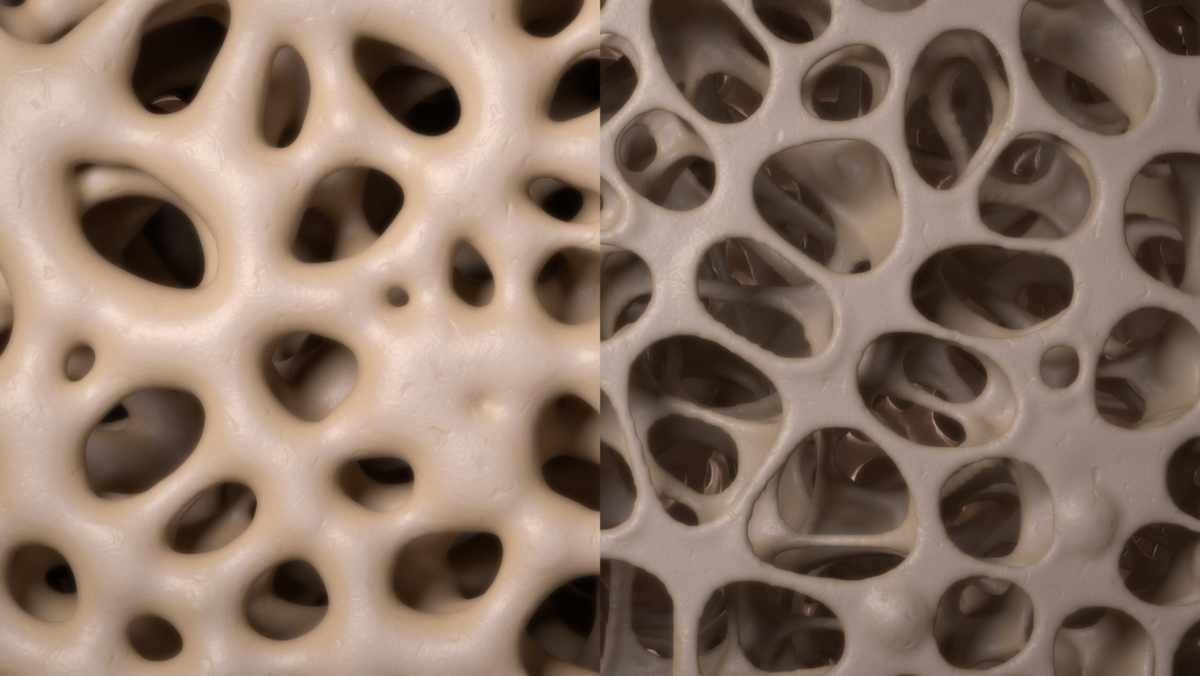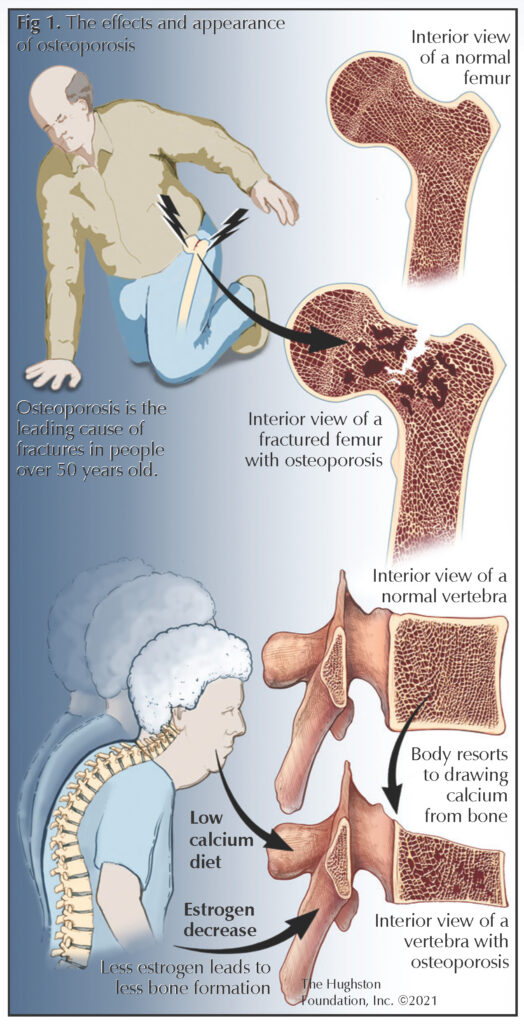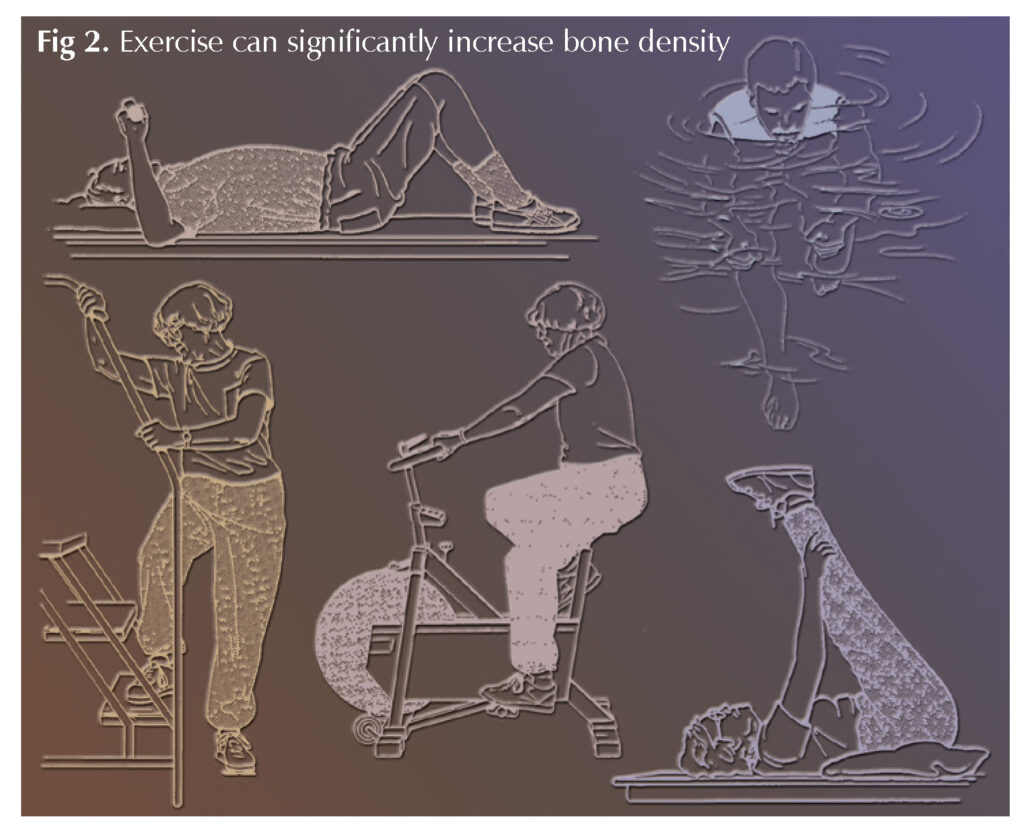
Like many patients, you may have questions about osteoporosis after receiving the diagnosis from your doctor. You may not understand exactly what it is or how you got it. You may not understand how your medication works or why you take a pill once a week but your friend takes a pill once a month. You may wonder how long you have to take the medication and if there is anything else you can do to improve the strength of your bones.
 What is osteoporosis?
What is osteoporosis?
Osteoporosis is a disease of the skeleton that is characterized by low bone-mineral density causing your bones to become thin, porous, and fragile. If your bone density drops too low, you are at greater risk of fractures, or broken bones. It often affects you as you age, and it is one of the leading causes of fractures in people over 50 years old (Fig. 1). It can affect both men and women; however, you are at a higher risk for osteoporosis if you are female, have had your ovaries removed, or if you have a low body weight. If you have a family history of osteoporosis, or a medical condition that causes osteoporosis, it is important to see your doctor to determine if you should be tested for brittle bones.
Fractures of fragile bones put thousands of people in the hospital every year and cause many of them to need surgery. A broken hip can be a terrible injury for a patient and even with the best medical care it can lead to severe complications. Often, people who break their hip never return to an independent life and often end up leaving their home for an assisted-living facility. Fortunately with treatments available today, the rate of hip fractures has declined by almost 33% in the past 10 years.
The first step in preventing a fracture from osteoporosis is having your bone density measured using dual-energy x-ray absorptiometry (DEXA or DXA). The DEXA scan is a screening test that measures your bone density and compares it to your optimum bone density. Women who are 65 or older, men 70 or older, and anyone who has a family history of osteoporosis should be tested. Fortunately, if you are at risk of fracture, there are treatment options.
 Can it be prevented?
Can it be prevented?
For most people, your bone density is best when you are young and in your 20s. From that age on, it begins to decline. Two things that help to prevent osteoporosis later in life are having a high bone density when young, and having a slow rate of bone density loss as you grow older. In a young person, a proper diet high in calcium and vitamin D and plenty of sports and weight-bearing activity like running can help prevent low bone density later.
Likewise, exercise and diet are important for improving bone density as we age (Fig. 2). Exercise can significantly increase bone density in people over the age of 50—especially when combined with dietary supplements of vitamin D and calcium. Exercise levels must be appropriate for your age and physical condition. Weight lifting and aerobics may be best for younger individuals, while dancing, walking, swimming, and yoga can be enjoyed by those with lower exercise tolerance.
How is it treated?
Exercise and supplements of vitamin D and calcium can help patients who are at risk for osteoporosis; however, for those who have already had fractures due to low bone density, additional medications may be needed. The most commonly used medications to improve your bone density are called bisphosphonates, such as Fosamax®, Actonel®, Boniva®, and Reclast®, that slows the process by which your body breaks down bone. Some of the medications are taken once a week, while others, such as Boniva® are taken once a month, Reclast® is taken intravenously once a year. All have been shown to reduce fractures, with up to 70% reduction in hip fractures and 40% reduction in spine compression fractures.
Estrogen or estrogen-like medications can also improve your bone density. If you are taking a medication like Evista® already, it can have positive effects on your bones. Depending on your health and your family health history, your physician may not prescribe the medication because of its possible side effects on breast tissue and your heart.
A new drug recently released, called Prolia® has shown good results in preventing fractures. Prolia® is an antibody that targets the signaling molecules in your body and prevents them from causing bone breakdown. For patients who have had complications from the other medications, Prolia® is available as an injection that is given every 6 months.
Most studies show that taking the medications for up to 5 years is safe; although, they can have some negative effects beyond that time. Currently, some doctors recommend that patients take a “drug holiday” to allow their bones to have some time to remodel and grow normally without any interference. The time without the medication is meant to allow new bone to fully mature and to become as strong as possible naturally. Also, some recent studies have shown that taking the medications for over 10 years can have adverse effects on your bones.
Although women are at a higher risk for osteoporosis, men are not immune. Fortunately the same methods of screening and treatment are effective for both men and women. If you have more questions, or wonder if you or a loved one is at risk for osteoporosis, you should speak to your doctor about it. Your physician can tell you if you need testing or treatment.
Author: James Larson III, MD | Columbus, Georgia
Last edited on November 9, 2021